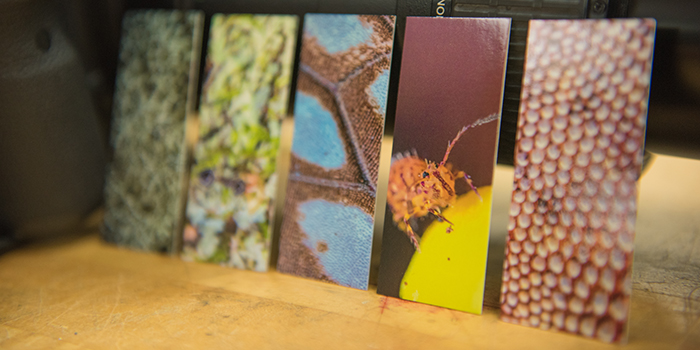Brand-building 101

A beginner’s guide to figuring out who you are, who you aren’t, and where you want to go as a business.
Branding your business is less about making something new, and more about defining what’s already there. Here’s how to discover your business personality and how to introduce it to the world.

Figuring out your brand identity
Your brand is made up of several overlapping parts. There’s who your customers are and what they want. And there’s your business goals, the way you operate internally, and how you stand out from your competitors. There’s also a good chunk of your own personality, and those of your staff – if you have them – in the mix, too.
All of this is expressed in your visual marketing materials and the tone of voice you use to communicate with the world, as well as the business decisions you make.
If your business is just starting out, you may not have begun building your brand just yet. Not sure where to begin? Well, as with so many things in business, it’s a good idea to start with the customer.
Learn more about brand building done right with RedBull’s story.

Ask the audience – building a customer persona
Try a simple exercise to build a picture of your customers. This will help you define why your business is valued and what it means to the people who experience it. Write down the answers to these questions to give you a starting thought:
- What is my average customer’s age, gender, interests, and budget?
- What’s the most important benefit we offer them?
- Why are they going to choose us above our competitors?
- What problems can we help them solve?
Maybe you have more than one customer personality. For example, if you sell jewelry, you might cater to people buying for themselves and people buying gifts for others. You can do this exercise multiple times to define different customer personas. If possible, get other people in the business to share their thoughts from the template above, too.
How to build your brand values
Brand values are an at-a-glance guide to your business personality – who you want to be, and what you believe in. Most companies have a list of 4 or 5, with each value summed up in a single word such as ‘clean’ or ‘harmonious’. They’re helpful in keeping you focused and consistent, as you can quickly check against them when making marketing decisions. Why not put them up on a wall in your workspace as an everyday reminder?
A helpful tool for creating your brand values is a card-sort. This is another pen-and-paper exercise, which you can do alone or with others.
- Using post-its, write down as many adjectives as you can think of to describe your business. Stick to single words, and write down whatever comes into your head.
- Separate them in to the ones you like and the ones that don’t quite fit. You can add a ‘maybe’ pile too if needed.
- Select 5 or 6 from your ‘yes’ pile, making sure you get a good mix and weed out any synonyms And ta-da! These are your new brand values.
Bringing it together with a look and feel
Now you’ve created a picture of your brand and its customers, you’re ready to start choosing ways to represent those ideas.
To help with messaging and marketing, you can develop a tone of voice to represent your brand. Use your brand values as a starting point for this, and start putting together some words, phrases and styles that suit (or don’t suit) who you are. For example, will you use exclamation marks? Emojis? Slang terms? Do you have a slogan?
On the visual side, you’ll want to choose a color palette, fonts and maybe some graphics to make your brand recognizable. Pick a small number of colors, maybe 2 or 3, and work with shades of those colors to keep things focused. Will your look be dark or light, clean or decorative? While you’re thinking about visuals, take a look at our post on how to design your first company logo.
Building a brand is an ongoing process, but it’s easier than you think to take the first step. Why not take your newborn brand out for a spin with a set of Business Cards?
Produce UK creates attention-grabbing events for high-profile brands that go far beyond the ordinary. Here’s how they get their larger-than-life ideas off the ground.
From a piano concert lit by 44 note-responsive pendant lamps, to a dumpster transformed into a gallery space, Produce UK is committed to creating events that offer ‘a bedazzlement of the senses.’
The artistic placemaking and event-making agency creates jaw-dropping experiences for world-class brands including Adidas, Hem and Hyundai.
The business was launched ten years ago by director Catherine Borowski. “I’d recognized the need for a truly artistic agency that blends fantastic experiences for brands and developers with an understanding of space, place and creativity,” Borowski says. “We’ve got an amazing team of creative talent; conceptual artists, producers, placemakers, thinkers, designers and art directors.”
By also including singers, accessory designers, artists, a life coach, a composer and helicopter pilot on the team, Borowski ensures the talent they use remains in-house, and part of the unique Produce UK world.
Events that make an impact
In March 2017, one of Produce UK’s most ambitious projects to date — SKIP Gallery — took form. Since launch, the gallery has held six exhibitions in its dumpster art space, and collaborated with some of the UK’s most prominent modern artists, including David Shrigley, Ben Eine and Gavin Turk.
Describing her brand as “fiercely independent, nimble and brave as hell,” Borowski’s work is a visual feast, sparking conversation and turning design into an experience that can be shared. “Our clients love working with us and we make them look good,” Borowski laughs.
Produce’s name is as simple as their M.O. — “We produce stuff,” Borowski says — but the feats she and her team dreams up are anything but. When they’re not cramming artistic spaces into dumpsters, they dream up and execute their projects on an grand scale.
Collaborations include a fully immersive seasonal pop-up in the shape of a giant, LED-lit slide at London’s Wembley Park, a ‘football fandome’ featuring a 91-meter, 360° wrap-around screen, and Borowski’s favorite event to date — the UK launch of RuPaul’s Drag Race for truTV.
“We put on a live runway show judged by RuPaul himself, who flew over for the finale,” Borowski says. “I’m a huge fan, and in person he’s generous, fierce, kind and as sharp as a knife.”
Inside the mind of a project
So what’s the process that leads to the ideas that make Produce UK stand so far out from the crowd?
“Our team of artists and creatives is always tuned into new emerging movements, trends, styles and production techniques,’ Borowski says. “Our criteria are to light up the imaginations of our clients, visitors and guests, and make something so visually sumptuous, the world feels compelled to share it on Instagram.
“We like to immerse ourselves in the client brand or space, whether that’s over coffee or a site tour, and get under the skin of our client to understand what makes them tick.” The resulting brainstorming sessions can be held anywhere, “from on top of a dumpster to the back of an Uber,” Borowski says.
The business’s placemaking arm taps into what she describes as “an obsession with non-places and office spaces,” turning eclectic public spaces into temporary sites for experiential events and exchanges.
“Our placemaking practice informs our event-making projects,” Borowski explains. “By drawing on all our resources, we create full 360 degree strategies, from concept to delivery. “Placemaking is the process of looking at public spaces from a holistic perspective, with the goal of amplifying the presence of a location in a way that’s relevant to its unique characteristics.
“In a nutshell, we create destinations and places that people go want to go to and hang out at.”
Marketing that stands out
In a business landscape that’s crowded with creativity, marketing is crucial to the brand’s success. “It’s essential that we conduct marketing the Produce UK way, and strive to be brave and creative,” Borowski says.
By exploring an eclectic variety of avenues, Produce UK have made sure they’ve got the presence to attract the large-scale products their creatives thrive on.
“Our tactics include researching and presenting a bi-monthly Trend Report, and having a strong presence on social media,” Borowski says. “We’ve also launched Place:Labs, which is a quarterly forum where people who work across different spaces can come together. We describe it as ‘a place lab to inspire the future.’”
This strategy includes Borowski’s Business Cards, which are as stand-out as her projects. “We’ve got the Luxe Business Cards on 600gsm, and boy are they fabulous,” she says. “I love the thickness and the weight — they scream ‘premium and considered.’”
As with most things related to Borowski’s business, her Business Cards have become a talking point. “Everyone loves our cards,” she says. “Every time I hand one out I receive comments on the thickness and requests for the contact details of our printers. I was recently in Japan, the nation of the business card, and even there I received amazing reactions.”
So what advice does Borowski have for anyone starting out in event planning? “Think outside the box. Be brave. Be a problem solver, not a problem creator.
“Keep your humor high and your smile big — it will open doors for you with clients and suppliers. Say thank you. Treat everyone brilliantly — from the lighting techs, location cleaners and designers through to the clients.”
The benefits of being excellent
So what advice does Borowski have for anyone starting out in event planning? “Think outside the box. Be brave. Be a problem solver, not a problem creator.
“Keep your humor high and your smile big — it will open doors for you with clients and suppliers. Say thank you. Treat everyone brilliantly — from the lighting techs, location cleaners and designers through to the clients.”
Borowski practices what she preaches, and is committed to supporting her 95%-female workforce. “That ratio was more by accident than design, but we offer very flexible working hours and recognise that everyone has a life outside of work,” she says.
Level up your brand with Luxe Business Cards.
Deciding to work on a business alongside your full-time job can feel daunting. Increase your chances of success (and of enjoying the journey) with these tips.
Making money from a passion project is a dream plenty of us would love to see become a reality. And if you’re thinking of launching your own business but still want to make the rent, a 6-11 could be the ideal solution.
Working late after a long day at work is undeniably a challenge. But it can be rewarding too, and might even grow into a full-time business. Follow these tips to make the most of your side hustle — without suffering burnout.
1. Take control of your money
Before any new business starts making money, you’re likely to have to invest in a few set-up costs, from materials and web-hosting to printer ink and a hike in your phone bill — so make sure you have enough financial wiggle room to get things off the ground. Make a list of all the things you might need in your first six months, and check that your wages or savings can cover them.
Once you start making money from your 6-11, it’s worth hiring an accountant to make sure you’re covering all the bases when it comes to tax, and understand what records you need to keep.
2. Check your expectations
If you’ve always wanted to be your own boss, a 6-11 is a great way of dipping your toe into the world of self-employment. But if you’re picturing yourself working from the beach in between poolside yoga classes within six months, you might need to adjust your expectations.
Turning your hobby or side-skill into your main source of income can take a lot of work, especially when you can’t commit to it full time. It’s likely to be a long-term process, so make your goals realistic — for example, ‘I want to land a regular client by Christmas,’ or, ‘I want to earn enough to cover a new bill each month.’
If you find you’re struggling with your workload, it might be time to scale down your hours and expectations accordingly. Turning your passion into a business is a fantastic goal, but working on a project you love is rewarding in itself — so if it’s not working out, it’s OK to give yourself permission to dial it back down to a hobby.
3. Take your brand seriously
Branding is a crucial first step towards building your own business — just ask Sarah from Geo Heaven, who’s making a big success of her 6-11.
From your name and logo to your tone of voice and Business Cards, crafting a brand identity based on your values, audience, USP, personality and story will help clients and customers to take you seriously — and it’ll give your self-perception a boost, too.
When you’re launching a business after-hours, time is of the essence — and once you know what your brand represents and how you want it to be perceived, you can make a splash quickly and consistently through your website, social media and Business Cards.
4. Make the most of social media
There’s nothing stopping you filling dead time during lunch breaks and at weekends with brand-building and customer service, which is what makes social media such a handy tool for small businesses.
As well as being a great way of getting your brand in front of a variety of different audiences, setting up dedicated Instagram, Facebook and Twitter accounts gives you a way of connecting with customers or clients when you’re on the move, reducing the chances of missing an opportunity.
Spend time taking some great photos of your product, and it’ll really make you stand out from your competitors.
5. Don’t treat it as a hobby
Your 6-11 might not be your main source of income, but you’ll only get out of it what you put in. Hopefully, you’re focusing on a project you’re already committed to — whether that’s graphic design or jewelry-making — so motivation shouldn’t be a problem.
But making it work as a business requires an entrepreneurial frame of mind — which means hunting for networking opportunities (and brushing up your networking skills, even if you’re not keen on it), researching your customer base, building an online presence, organizing your finances and writing a business plan. In short, take your 6-11 seriously and other people will, too.
6. Look after number one
If you’re working during the day and in the evenings, you have to be ruthless with your time — although you might suddenly find you’re much better at prioritizing when your choice is between catching up with friends and sorting through spam email.
Even if you’re great at sorting out the essential tasks from the less-crucial ones, tacking another job onto the end of an already demanding day can take its toll, so make time for some self care (trying these 5 homeworking habits should help).
You’re doing something amazing, so reward yourself regularly — even if it’s just with a really great cup of coffee to keep you going.
Ready to take the plunge? Spread the word about your new business with a dedicated set of Business Cards.
Shipping can be costly for online businesses, but with a smart strategy you can keep your customers content and your margins healthy.
Let’s be real – nobody likes to pay a shipping fee on top of the price of their item, and with many retailers, they don’t need to. Customers have come to expect the same convenience from online shopping that they’d find in a bricks-and-mortar store, where delivery cost is nil (and so is the cost of sending back returns). Thanks to competition among retailers to offer the best online shopping experience, it can be difficult to keep up while maintaining your profits.
Check out some popular shipping strategies and find out which one is right for your business…
1. Shipping by weight
This is the most transparent option, where you pass the shipping and packaging cost directly to the customer. It’s more straightforward administratively, as your shipping costs aren’t subject to profit or loss. It also allows you to set your prices competitively, as you’re not covering or subsidizing shipping as part of your business overheads. On the downside, it could discourage customers from buying larger items or bigger quantities, particularly if the items you sell are heavy. Great for Postcards, not so good for pottery.
2. Flat-rate shipping
When the shipping cost is the same for every order, things are straightforward for you and your customers. It also offers customers progressively better value the more they buy in a single order. Of course, it will end up costing you more if they buy items that are heavy or bulky, but hopefully the amount they’re spending will offset this. Flat-rate shipping can be prohibitively expensive if your items are shipping from different locations, for example if you’re running a drop-shipping operation.
3. Free shipping on everything
For many customers, this is the gold standard of shipping policies – what’s not to love about free delivery? From a business perspective, having at least one economy shipping option that’s always free means you can avoid that potential dropout point where customers see their combined total and abort their purchase before checkout. But to make sure you can absorb the cost of all that shipping, you may need to set your prices slightly above the market average.
4. Free shipping threshold
This is a popular choice among online retailers. Shipping costs are waived above a certain amount, e.g. $40, so customers get a benefit for spending more. It can provide a powerful nudge towards adding an extra something-or-other to the shopping basket to meet the threshold. This option can act like a price anchor too, setting an implied budget for customers when they begin to browse your site. If you set the threshold at the right point, in theory you can balance out the free shipping costs against the extra profits from these high-value transactions.
5. Subscription for priority shipping
Alongside your standard shipping options, you can set up a subscription program where customers sign up for VIP shipping at no extra cost (and other perks, if you like), in return for an annual fee. This model was pioneered by Amazon with its Prime service, and has also been adopted by ASOS and UK supermarket Morrisons, among others. It’s a great way to encourage customer loyalty and repeat business, since the customer is making an investment that they’ll want to get the maximum value out of with repeat orders. Not everybody will want to join, so you’ll need fallback shipping options too.
Putting it all together
There’s no reason you can’t combine multiple shipping options, including a free service, a VIP priority program, special offers on shipping costs, and other services like next-day or signed-for deliveries. Your customers are likely to appreciate having several options, and you can track their choices as a guide to help you refine your future shipping policies.
Want to know what your customers think? Include a Flyer with your deliveries that sets out your shipping policies and invites them to feed back on what option they prefer.
Where do clients come from? And how can you turn a new client into a loyal customer who’ll come back to you time and again?
Finding clients
Whether you’re transitioning out of employment or you’ve recently graduated, finding your first freelance clients can take some work. Fortunately, at this point you can make it your whole focus – later on you’ll have paid work on your plate too.
So you have the time and the motivation, all you need are some places to start looking. Here are some ideas to help you get started…
1. Explore your local trade show and event circuit
Grab your trusty Business Cards and a stack of Flyers and get on the events circuit in your area. You can find listings for events online, using sites like Eventbrite and Expodatabase, or follow the trail on Twitter and Instagram using hashtags like #tradeshows, #eventmarketing and #exhibitions. Once you’re there, it’s all about the networking…
2. Be a problem-solver on social
People love it when a solution finds them rather than vice versa. That’s why it’s worth hitting a few inboxes at companies you’d like to work for, even if they’re not actively recruiting for suppliers. LinkedIn is a great tool for this, as you can use it to research and target the right people, and automatically link them to your profile. You could chance on somebody who’s been wanting some help but hasn’t yet got around to searching for it, or make a connection that could lead to some work in the future.
Check Twitter, Facebook and your own LinkedIn feed for questions you can answer. This is a neat way to showcase your expertise to potential clients and earn a little karma at the same time. Make sure your social profiles include a link to your website or online portfolio for best results.
3. Connect with other creatives
Does your city have a thriving creative scene? If so, try attending a meetup group with fellow creative professionals. Meetup.com dominates as the place to find these, but you can also try communities like Reddit’s /r/webdesign to scout out local groups. This will help you get an idea of what kind of work is in demand, what other people in your field are charging and whether there are major projects or organizations that could use extra resource.
You should also check out local incubators and business support services. Universities and large organizations often set these up to foster entrepreneurial talent, and even if you’re not eligible for membership, they may have a jobs board or some ad hoc recommendations to offer.
Keeping clients once you’ve found them
Finding clients is hugely important, but it’s only half the story. Client retention – i.e. repeat custom – can be even more valuable than attracting new business.
That’s because once you’ve established a working relationship, it becomes quicker and easier to get jobs done. You have a built-in understanding of the client’s market, brand and company culture, and it’s more efficient for them to get you briefed on a new project. They can even help you find new clients by recommending you to others.
On top of that, repeat business is 7x less costly than acquiring new business, according to Inc.com.
Here are 3 ways to keep these kinds of connections going…
1. Geek out on their industry
Demonstrate your commitment to your clients by taking note of what’s happening in their field. Spotted a new trend in their product area, or a regulatory change that’s going to affect their business? Get in touch to see how you could help. As well as cementing relationships with your clients, doing your homework like this can help you develop a specialism that will help attract other clients in the same business niche.
2. Find a personal connection (which may involve cat GIFs)
Human relationships are incredibly powerful in business, but like any connection, they have to be authentic to be worthwhile. Any small but genuine link between you and your client contact will help them to remember you and create a positive association with your work. As you chat, find a point of commonality with them, whether it’s a shared love of a sports team, a hobby you both enjoy, or the simple joy of amusing cat gifs shared via email.
3. Become a shape-shifting adaptability machine
Be proactive in asking for feedback and acting on it. Your ability to flex and adapt to your client’s needs over time will make the difference between short-term help and long-term partnership. Keep track of their business goals, their challenges, and any changes in management structure and personnel, and be ready to adapt your ways of working accordingly.
Bonus tip: Send a post-project Postcard
After finishing a successful project, end on a high note by sending your client a Postcard to let them know how much you enjoyed working with them. It will help them remember you when new jobs come up in the future.
New to running your own business? Check out our guide to managing your first client relationships.
These three paper artists turned their product packaging into an artform.
There’s a lot of talk about delivering surprise and delight to your customers. But how do you actually bring that idea into reality? According to these three paper artists, personalized packaging is a great way to start:
Fatto Ameno
Fatto Ameno is a design studio based in Milan, Italy. Started by artist Laura Sauchelli, Fatto Ameno is committed to bringing more joy into the world. All of her products celebrate the small details in life, from beautiful stationery for a ‘Thank You’ card, to paper goods that make a gathering a little more special
Fatto Ameno’s designs center around basic shapes and primary colors, which are intended to evoke nostalgic feelings of childhood. To do this, Sauchelli carves rubber stamps by hand and layers the stamps to create geometric designs and animals. The hand stamping also creates a unique impression on each print, giving each piece a one-of-a-kind feel.
Since first impressions are crucial, Laura wanted to make sure that her business cards communicated the kindness that is central to her business. “I love the fact that I printed a plain design on Luxe Business Cards, and only included my essential information,” Sauchelli said. “That gave me the freedom to personalize every card with a rubber stamp of my own. It’s really important to me that every potential client receives a unique, joyful card!”
Customize your brand on Luxe Business Cards.
Kathryn Willis
Kathryn Willis Paper started like many great ideas–– by accident. It all began in 2016, when she created a paper-cut portrait of a friend’s dog. “That friend told another friend,” Willis said to MOO, “and two years later, I’m still creating an army of hand cut, whimsical portraits of people’s furry family members.”
Willis started her online shop and a brand to go along with it—a bright, bold aesthetic that captures all of her subject’s bubbling canine personalities. Clients commision Willis by sending in photos of their dogs along with their names. With those images, Willis crafts and cutting her paper portraits in her own unique style.
But the customer experience doesn’t stop there. Willis also gives her patrons a handwritten “thank you” card that includes a snipped of paper that was used for the portrait. These cards are printed on the Luxe Notecard paper, with a seam that matches the color scheme of the piece. As if that’s not enough customization, she also seals the envelopes with a branded Sticker and a “For You” hang tag that’s made out of matte MiniCards. That level of attention to detail is unexpected, and always delights customers.
For example, a client once opened Willis’ notecard, assuming it was an invoice. She was pleasantly surprised when it contained a sweet handwritten note and teeny-tiny pieces of paper from her newly commissioned artwork. “She loved having those little gems from the process that created her beloved paper pet,” Willis said. “I trust MOO to support my brand and to set the tone for my business.”
Level up your customer experience with Notecards, Stickers, and Letterhead.
Puro Papel
Catalina Rojas, the founder of Puro Papel, is a full-time letterpress printer, designer, and book binder based in Miami, Florida. Her work focuses on limited edition print runs and custom packaging for other brands and businesses, with a classic and authentic design aesthetic.
Recently, Puro Papel created a unique gift for one of their customer’s birthdays. “My client wanted some kind of card that she could give each day to her friends with an inspiring quote and a hint of what the celebration was about,” Catalina said. “I suggested a box where she could hold all of the cards, to keep the whole weekend experience as a keepsake.”
Turns out, the MOO Luxe Postcard box was the ideal size for her customer’s vision. To keep the gift aesthetic consistent, Catalina recycled the box, printed a silhouette on each, and added a Salta stamp. Inside, each box contained a kit inside to write affirmations. “It was like a fun little toy!” Catalina explained.
The edge of color on the seam of each card was a huge hit with the recipients. And just as importantly, Catalina was happy with how the finished product represented her company. “I pick my cards and materials very carefully,” Catalina said. “They have to be part of the personality of the project. Because of their variety of finishes, MOO provides that possibility.”
Spread the joy with Luxe Postcards.
See how to nail business tasks like printing, typing and taking card payments on your phone with a few clever tricks and tools.
These days, the cellphone is a miniature computer that sits in your pocket and does almost everything your laptop can. It’s not a perfect portable office, we’ll admit, but with a little ingenuity, you can use your smartphone to run your business whenever and wherever you are.
Here are some ways to work around your smartphone’s limitations and make it into an all-singing all-dancing business base.
1. Typing and printing
Updating your socials on a smartphone’s keyboard is no problem, but if you’re doing something more in-depth, like updating your website, taking notes or filling in forms, you’re likely to hit some pain-points, particularly if the website or document format you need to use isn’t mobile-optimized.
Never fear though, there’s a plethora of portable Bluetooth keyboards that can help out. Some of them fold up, while others are just very small and light, making them suitable for slipping into a backpack or even a pocket. Look out for one with a built-in smartphone stand.
When it comes to printing out essential documents such as contracts and packing slips, it’s now possible to do it directly from your smartphone. The latest wireless printers are smartphone-compatible, with some even using NFC to make a direct connection between the two devices. Then there’s cloud printing, which allows you to send documents to your WiFi-enabled printer from any internet-connected device (including your phone) via services like Google Cloud Print and Canon Maxify.
2. Taking payments
Selling online presents no problems for smartphone-only businesses, but if you’re out and about at trade shows or pop-up events, being able to accept cards as well as cash can make a huge difference to your takings.
Fortunately, using services like Square, BluePay or PayPal Here, you can turn your cell into a card machine with minimal effort.
Download an app and send off for a card-reader device, and you can accept card payments just like you would with a till. There are swipe-based and contactless card reader devices available, some of which physically plug into your phone and some which work via Bluetooth, handy if you’d prefer to keep your phone in your own hands during transactions.
It’s worth noting that you will pay a charge for using these services, which could be a monthly flat fee or a per-transaction cost. It’s a good idea to weigh up the advantages of being able to take payments with the costs before you take the plunge.
Tip: if you’re at a busy trade show, help your card reader stand out and avoid getting mixed up with other people’s by adding some branded Stickers – just add some when you order Flyers or Postcards for your stand.
3. Product photography
OK, so it’s possible to do wonderful things with state-of-the-art phone cameras. (Entire feature films have been shot on iPhone cameras, after all.) But what if you’re working with a mid-range model with an average quality camera, or an older phone that hasn’t quite got the mega-pixels to meet the latest standards?
Buying a brand new phone or a separate camera isn’t the only option. You can attach a separate third-party lens, which will give your phone camera extra effects like telephoto and wide-angle. Ollophoto, Photojojo and others make small, affordable cameraphone lenses which are compatible with a wide range of phones. There are pricier options too, but we’re guessing that with a large budget most people would prefer to just buy a new phone.
You can also use some DIY techniques and easy hacks to improve lighting, get better angles and hold your phone steady, which could really help with taking photos of products.
Momofuku has split into multiple brands across the globe, yet remains uniformly loved by customers. How did they do it?
This restaurant brand has 11 full-service restaurants, 5 Fuku takeaway locations, and 13 Milk Bar baked good stores—all across the globe. And while they range in price from a casual fried chicken sandwich at Fuku to 2-Michelin Star dining at Momofuku Ko, they have fans who are loyal to all.
With so many different properties, how did the company manage to maintain their brand identity? We sat down with Marguerite Mariscal – Momofuku’s VP of Brand & Design – to find out.
Where it all began
Momofuku Noodle Bar opened its doors in Manhattan in 2004, right after chef David Chang came back from Japan. His trip had inspired him to try bringing fine-dining cooking techniques to more humble food like ramen.
By taking the concept of a traditional Japanese restaurant and adding local American ingredients, Momofuku Noodle Bar did what no restaurant had before.
That same level of innovation runs throughout all the restaurants, regardless of price point. “I think that’s what builds it more into a brand,” Mariscal said. “We have fans that are loyal across all the restaurants, so it’s clear that they’re fans of more than just the food that we’re offering. We’ve made a conscious decision to brand our restaurants in a unified way. ”
And what does the name Momofuku mean? “It means “lucky peach” in Japanese,” Mariscal said. “Chang liked that it’s a little nonsensical.”
One big umbrella
We asked Mariscal how Momofuku unites so many different locations under one brand. According to her, a key theme is quality. “Regardless of what we’re offering, we attempt to offer the best version that you’ve ever had,” Mariscal said. “The food is always the priority.”
That commonality to how they approach food is how Momofuku converts people into fans of multiple properties. “People who like the Noodle Bar are probably going to like the Ssäm Bar. It’s the same attitude and approach, but in a different form,” Mariscal said. “Whether it’s through social media or collateral, we always want to express our brand consistency. There are just variations between each restaurant.”
Unifying the brand
With so many properties, Momofuku now has over 1,000 employees around the globe. As Mariscal explained, creating a unified culture with such a global workforce has been a challenge.
“How we communicated our culture in the beginning simply doesn’t work when we bring in a ton of new restaurants,” Mariscal said. To address this problem, Momofuku currently runs a “Momo-101” course with all their new employees. The staff has the chance to meet Dave, and have a conversation with him in person.
“He gives a history of the company and an overview of our values,” Mariscal said. “It’s less about telling them what to do our how to act and more of giving them enough examples of how we operate.”
The Momofuku team wants to give their staff the agency to make good decisions and what they call “smart mistakes.” In other words, they want their employees to intentionally push the boundaries and make game-time decisions.
“If people care about their jobs and what we do here, then they will feel ownership over their decisions,” Mariscal said. Momofuku wants employees who are never satisfied and want to keep improving. “We are never done tweaking the menu or tweaking the service,” Mariscal said. “Nothing is safe from that purgatory.”
Taking the brand further
Almost every Momofuku location has Business Cards as a takeaway – even the executive chefs carry them around. “It’s a personal touch that allows them to interact with a guest and invite them back again,” Mariscal said.
The look of the cards is different for every restaurant. “Since we’re everything from fine dining to quick-service restaurants, we need a lot of different looks within the same theme. That’s why we love MOO Business Services so much,” Mariscal said. “We get the flexibility to express the personality of our individual restaurants, as well as Momofuku as the overarching parent brand.”
Tell your brand story with MOO Business Services
At MOO, we’ve been helping people make their mark in the world with amazing quality print products for over a decade. And as our customers have grown, so has our service offering. That’s why for bigger businesses—with 10+ employees—we now offer MOO Business Services. It’s MOO + benefits. MOO Business Services combines dedicated account management with an easy online ordering platform and expert design services. It’s a complete package for businesses to give you more brand control and consistency—while saving you time, stress, and money in the process.
Fill out the form here and a friendly Account Manager will reach out to you.
New to running your own business? Here are some guidelines to help you get your client relationships off to a great start.
If you haven’t dealt directly with clients before and you’re not naturally a silver-tongued Don Draper type, you might be wondering where to begin. But working with clients isn’t really that different from any other business relationship. Essentially, you both have goals and you just need to plan out the best way to meet them. Here are five tips to help you do just that.
1. Use a contract
It may feel a bit heavy-handed, but putting a contract in place is a great way to set up a relationship and give yourself some extra peace of mind. It doesn’t need to be super-complicated or long, and you almost certainly don’t need a lawyer. Many freelancers choose an informal style of contract, such as a letter of agreement, which sets out who has agreed to do what, and when.
A statement of work is another kind of contract which is popular with design and creative professionals. It goes into a little bit more detail about how you’ll tackle things like amends, payments and intellectual property rights.
Set these documents up in advance if you can, using a boilerplate version that you can tweak and amend for new jobs as they arise. If you’ve got some business branding in place, e.g. for your Business Cards or Letterheads, you can include it on the document for that extra-professional feel.
2. Keep them posted
Keep your client in the loop with regular communication. They probably don’t need a daily bulletin (unless they’ve specifically asked), but it’s a good idea to proactively let them know every week or so:
- what you are doing
- what you plan to do next
- anything you’re going to need from them, such as feedback or source material
There are a couple of reasons for this. One is that it saves your client the effort of checking in with you and keeping things moving along. Another is that it prompts them to tell you about any changes or plans that could affect your work. It could even lead to them thinking of you for additional projects, as you’ll be at the front of their mind.
If you need something from your client or you’re waiting for a reply, send them a friendly chase-up email or pick up the phone. If they’re busy and have a lot of things flying around, this can be really helpful. (Don’t chase them too often of course, but a little bit is fine.)
3. Plan for payment schedules
One area where freelancing differs dramatically from salaried work is how often you get paid. After you submit an invoice for work you’ve done, you’ll need to wait for it to be paid. How long this takes varies from client to client.
For some companies, it’s typical to pay invoices within 30 days, and for others it’s 60. Some don’t have a fixed policy.
Your client’s process is likely to be the same for all its suppliers, whether they’re one-person companies or major businesses. So it’s a good idea to always ask a new client what their payment terms are. Once you know, you can plan ahead and make sure you’re not left out of pocket.
4. Don’t be afraid to talk about money
Negotiating prices, providing quotes and making sure you’re paid fairly for the work you do is a fundamental part of being self-employed. It can also be one of the most daunting areas for first-time freelancers, but it becomes much easier once you’ve made a few key decisions.
One of the first things to do is establish your rates, whether they’re hourly or by the day. Compare notes with other freelancers in your field if possible, or check out sites like Upwork, which shows rates for many freelancers in a range of fields, or freelancer.com, which gives you an idea what companies are prepared to pay for specific jobs. Once you’ve decided on your rates, you can use them to price your work and negotiate with your clients.
It’s also a good idea to think about whether you want to work on a project or a time-and-materials basis.
- With project-based costs, you charge a set amount which is agreed at the outset. This is a good way for clients to make sure they’re working within their budgets. But it needs to be accompanied by a clear statement of work to make sure you don’t get asked to do extras that aren’t covered by your original costs.
- Time and materials means you keep track of the work you’ve done and bill the client on a regular basis until work is complete. This kind of billing is good for projects that change as they go along, or for work with an unpredictable schedule. It requires a bit of extra admin in tracking your hours, but it means you won’t be out of pocket if there’s more work than expected
5. Keep in touch once the job is done
Everything’s gone well, the project’s complete and your client’s happy with what you’ve done. If you’ve done a good job, they may well want to hire you again. But the chances are they’ll move on to new things quickly, and won’t always remember you unless you make the effort to stay in touch.
Keep things light and low-key, dropping them a line every couple of months to stay in touch. If you’ve found a relevant news story or link to share with them, you can make this the subject of your message, and sign off with a reminder that you’re around and available for work.
You can also use the mail to stay in contact – why not send them some Postcards or Flyers showcasing your latest work, or a product sample wrapped and finished with a Sticker?
Your company is constantly evolving––which means your onboarding kit needs an update.
The key to a positive work culture starts from day one—and onboarding kits are an effective way to begin. They set the stage for every new hire to succeed at your company, and they’re a fun way to introduce your brand. But here’s the deal–– as your company grows and changes, so should your onboarding process.
Sure, updating a company-wide kit can be a big task. But it’s even less time efficient to explain new company policies, department roles, and values over and over again.
If you haven’t taken a look at your onboarding documents in a while, flip open that trapper keeper. Then grab a pen and your editing hat, because it’s time to make some changes:
Who does your business serve?
Every company should train their new employees like they do in the hospitality industry: by focusing on how to treat their customers. But as your business has grown and more products and services released, your customer base may look a bit different from when you started out.
A brand is nothing if its users don’t feel valued. As a result, your training manual should emphasize best practices for every type of customer interaction. All new starters should have a clear understanding of what experiences your business wants to deliver to your customers from day one.
Champion your company values
As Marian Wright Edelman famously said, “You can’t be what you can’t see.” In other words, if you don’t get your company values on paper, they might as well not exist. These could be anything from diversity and inclusion to humor, curiosity, and a hunger to learn.
If you’re struggling to summarize your organization’s values in a few words, check out this step-by-step process. It’s a really helpful exercise in synthesizing your ideas and getting to the few core words that summarize them.
Once your brand values are clarified, it’s important to keep them in sight. We recommend printing your guiding words on well-designed postcards and adding it into your company’s onboarding kits.
All new starters should have a clear understanding of what experiences your business wants to deliver to your customers from day one.
Wait, who are you?
It’s your first day on the job and it seems like there are countless people from different departments to meet. The first-day jitters are hard enough, so take the extra pressure off your new hires by printing out a detailed organization chart.
Just have everyone’s picture, title, and department laid out in one document, and make it easily accessible in the company Google Drive, ready to stealthily draw up on your phone at any moment. This will save everyone from some uncomfortable moments, and illustrates to your new teammates how the different departments work together.
For larger company events, you can make the real-life version of the spreadsheet with a simple addition: nametags. Leave some space for first name, then an area to answer an icebreaker. Your onboarding process should make time for meet-and-greets to help your hires get settled quicker.
Some of our favorite prompts include, “What’s your superpower and weakness?” “What was the last thing that made you laugh?” and, “What was the first job you ever had?”
Check yourself
We know that you’re busy, and it can be hard to dedicate a lot of time to your new hires. This is where checklists can be a lifesaver. They ensure that additions to the team have an answer to a lot of their procedure-based questions.
Some vital checklists to include in your updated onboarding packet include: brand values workshops, company history quiz, how to design your business cards, benefits enrollments, and some employee-favorite lunch spots.
As your company continues to grow, be sure to keep your onboarding process up to date. Your new hires’ first impression of your company will set them off on the right foot from day one.
Onboarding made easy with MOO Business Services
At MOO, we’ve been helping people make their mark in the world with amazing quality print products for over a decade. And as our customers have grown, so has our service offering. That’s why for bigger businesses—with 10+ employees—we now offer MOO Business Services. It’s MOO + benefits. MOO Business Services combines dedicated account management with an easy online ordering platform and expert design services. It’s a complete package for businesses to give you more brand control and consistency—while saving you time, stress, and money in the process.
Fill out the form below and a friendly Account Manager will reach out to you.
Award-winning photographer and National Geographic Explorer Matthew Cicanese on how he found his niche and gets himself noticed.
Natural history photographer Matthew Cicanese describes himself as specializing in, “macro photography of what I call Earth’s underdogs and outliers — the things we as humans tend to forget about.” But how does he keep his focus on the detail while dealing with the wider picture of managing a successful career?
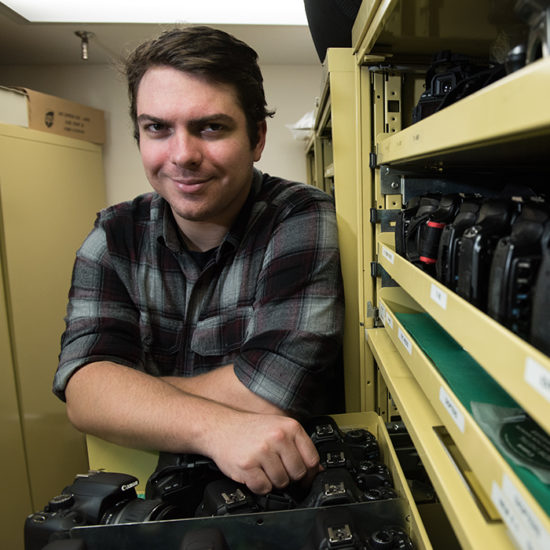
A National Geographic Explorer, documentary artist and Emerging League Photographer with the International League of Conservation Photographers (iLCP), Matthew is also a meningitis survivor who lost the sight in one eye and hearing in one ear.
A childhood spent soaking in the minutiae of nature drove Matthew to explore a little-seen world via his stunning photography, documenting the absorbing details of nature that are all around us, but rarely paid close attention to.
We spoke to Matthew about how he’s turned his passion into a career, how artists can help themselves stand out from the crowd, and the benefits of burrowing down into the detail.
So, Matthew. Tell us a bit about yourself and your background.
I grew up in Dade City, Florida, exploring the oak forests around my home. I’ve always had a deep fascination with natural history — if I wasn’t playing video games, I was outside exploring the forest in my backyard, catching bugs, climbing trees, and chasing lizards.
At university I studied environmental science, then I went on to earn my Masters in Experimental and Documentary Arts. Now, I work independently, creating artwork, visual storytelling, science communication and conservation stories for entities from NGOs to educational institutes around the world.
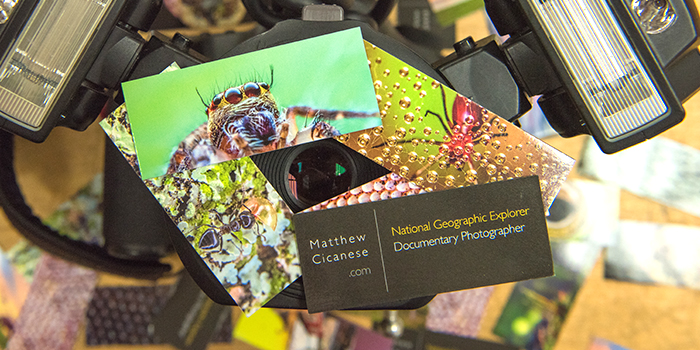
When did you know you wanted to be a professional photographer?
The way I experience the world has always been different from how most people do. Somehow, the sensory deprivations of being a deaf-blind inspired me to marvel at Earth’s hidden details, and study them with a deep obsession.
I learned early on that most explorers and adventurers don’t specialize in photography, but rather in the natural history subjects that fascinate them.
I specialize in the organisms that are always in our field of view, but most often out of our frame of mind. Lichens, fungi, mosses and insects are just a few subjects in this vastly-overlooked group that help make our planet function properly.
I have a unique vision for how I see and document my subjects that combines my childhood curiosity of exploring the woods, my passion for scientific knowledge and my ability to evoke narrative themes in my work that stir visceral reactions.

How did you end up becoming a National Geographic Explorer?
In 2016, I received a grant to carry out an expedition in Iceland to document the biodiversity of lichens living there. Becoming a National Geographic Explorer means becoming a part of a global community of individuals who are deeply dedicated to their way of showing people the world in a new light.
What advice would you give to photographers looking to get their work seen?
Getting your work published should never take precedence over the desire to produce it. If you’re more worried about getting your work recognized, and don’t have the drive to actually produce work, that can really get in the way of growing as an artist.
That said, along with joining social media communities, I recommend networking at conferences, portfolio reviews, and other venues where industry influencers meet — it’s a great way to get your work out there.
Do you have any networking tips for photographers just starting out?
You have to be bold and willing to stick your neck out to introduce yourself as much as possible, but without being a nuisance. It’s a delicate balance, but after a few years of doing it, I’ve found people are starting to seek me out, rather than the other way round.
The hardest part of putting yourself out there is getting shot down, but you have to be willing to dust yourself off, and try again. You have to look at ‘failure’ as a stepping stone towards success — otherwise it’ll become an anchor that’ll weigh you down.
It looks like you’re always on the go – how do you stay organized?
I make weekly to-do lists and prioritize my tasks accordingly. When it comes to scheduling, I keep a really detailed calendar, which has been a life-saver. Knowing what’s coming up down to the smallest detail helps me attempt to orchestrate the chaos.

How did you go about building your brand identity?
Your style of work, language, values and goals should all match up to represent your overall brand. If you don’t brand yourself, it’s only going to slow down the process of becoming better recognized for your style of work within your niche.
Having a well-designed website is also a given for any professional trying to strengthen their brand identity. Don’t get too caught up with things like logos — just provide a solid place with a breadth of information and a portfolio of only your best work.
What impact has social media had on your career so far?
Social media is critical to the development of and engagement with an audience for my work. It provides me a way to keep them up-to-date on my latest work and share experiences.
For platforms like Instagram, it’s important to only upload strong work that fits your niche, and to interact with that niche community in genuine ways.
‘Stories’ features are great for involving your audience — although it’s also important not to overshare, and to keep them wanting more.
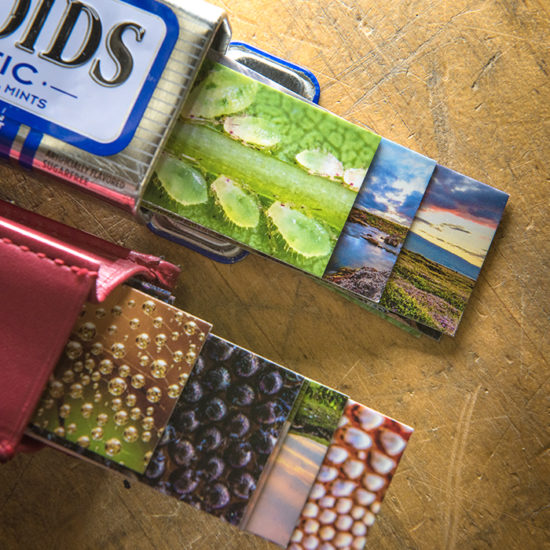
Tell us about your MOOcards – why did you choose MiniCards to highlight your photography?
My cards feature an eclectic array of subjects from my work — I chose high gloss so the colors and sharpness of my photographs would translate well to print.
I use MiniCards because I believe Business Cards shouldn’t be over-cluttered with information, and I wanted to minimize my carbon footprint.
I also think the unique size works well in providing a glimpse at a scene or subject without revealing too much of the bigger picture, which invites people who receive my cards to explore my site to see the rest of the photograph.
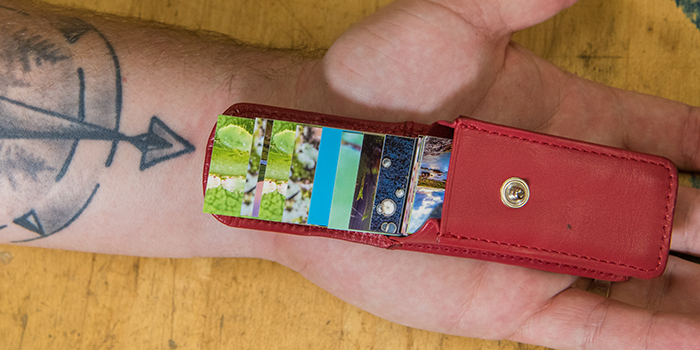
What’s the reaction been to your cards so far?
The reactions are always delightful. People often want more than just one — they’re like collectible pieces of bite-sized art.


































































